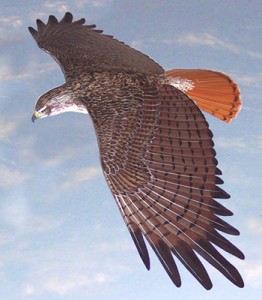Bird Watching
The red tail hawk with his lethal claws splayed came swooping out of the sky and grabbed the rabbit. The giant bird, eighteen inches long with a four foot wingspan tried to take off, its strong wings beating the air, but the impaled animal was too big. Earthbound, the hawk dragged his prey to the shelter of the cedars. We saw fur fly but were too far away to observe the gory details. After a while, the hawk flew, part of his catch clamped in his talons. After the bird had gone, we went to examine the site. The hawk had eaten some and left what he couldn’t carry.
That was the largest bird we had ever seen in our yard.
Then, a few weeks later, a turkey vulture landed on the top of the birdfeeder pole. When I saw vultures circling in the sky their wings spread to a full six feet, I never thought I’d see one up so close. This one filled the kitchen window, his hunched body, more than two feet long. He turned his ugly, wrinkled red head with its menacing, hooked, yellow beak and stare at me with bead-like, black eyes. I stared back, not daring to move. He turned away and cocked his head. What was he listening to?
Suddenly, my heart raced. The dogs. The vulture was certainly big enough to carry off Dudley, the dachshund, if not the slightly bigger schnauzer. Where were they?
I bolted to the back door and called them. They trotted obediently into the house, unaware of the danger. When I returned to the kitchen window, the vulture was gone.
Every spring, my friend Cathy has birds nesting in a climbing rose bush on her front porch. Sometimes they are chirpy little house wrens and sometimes big, robust robins. The nests are just a bit over eye level but low enough so that the babies’ gapping mouths can be seen. On a good day, you might even get to see them fledge.
We don’t have a front porch or a climbing rose bush but we do have a big, bird-friendly back yard. Ever since we built Glenn’s new office with a king size window, he has become an enthusiastic birdwatcher. He bought new feeders and keeps them filled with sunflower and thistle seed.
Four cardinal pairs nested in the Leather Leaf Viburnums this year and now the feeders are loaded with crestless youngsters, as many as eight at a time. Numerous gold and house finch flit about, quarrelling over the seeds. The feisty little hummers dart among the red cannas. The morning dove pairs are the picture of domestic tranquility, huddling together and feeding one another.
Last spring, a brown wood thrush with a brightly speckled breast built a nest a few feet off the ground in the white pine tree but abandoned it when one of the dogs got to close. She (I prefer to think it is the same bird) still comes to the feeder every now and then and takes dust baths in the dirt under the tree. We’ve noticed that rabbits take dust baths too. Some think they do that to rid themselves of parasites. I think it must feel good.
Finally, last evening, I saw the outlined shape of a smaller hawk, black against the evening sky. It might have been a Cooper’s hawk, flapping its wings, swooping and diving before finally disappearing into the night. Cooper’s hawks are known to preys on bird feeder birds such as sparrows and finch. This particular hawk was being chased by two smaller birds, probably to draw it away from their new hatchings.
Birds add much joy to our lives. We love spotting new ones as well as old so we keep our eyes open and our binoculars handy.
Because of the Gulf oil spill, the Audubon Christmas Bird Count will be more important than ever this year. It will be held from December 14, 2010 to January 5, 2011. Check the Audubon Society web page for more details.



Leave a Reply